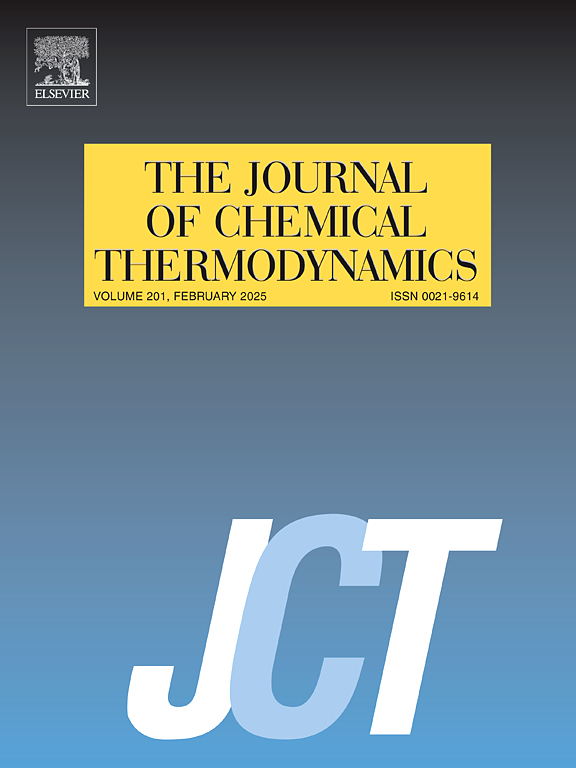食品包装迁移物的实验和预测水溶性和蒸汽压:4-正辛基苯酚、4-叔辛基苯酚和 4-正壬基苯酚
IF 2.2
3区 工程技术
Q3 CHEMISTRY, PHYSICAL
引用次数: 0
摘要
4-正辛基苯酚(4-n-OP)、4-正壬基苯酚(4-n-NP)和 4-叔辛基苯酚(4-tert-OP)是食品接触材料中的危险化学品。为了能够从接触途径、化学动力学(归宿)和迁移(迁移过程)等方面对它们的健康风险进行评估,我们研究了它们的物理化学特性:水溶性和蒸汽压与温度的函数关系。文献中缺乏与这些特性相关的数据。我们采用动态饱和法在 298.15 至 328.15 K 之间测定了这些分子的水溶性。使用静态和动态气体饱和法测量了烷基酚的蒸汽压。4-n-OP 和 4-n-NP 在 298.15 K 时的蒸气压最低(低于 10-3 Pa)。第二步,利用实验水溶性和蒸汽压测量值计算亨利定律常数和空气-水分配系数。所有实验数据都与现有文献数据进行了比较,然后与 UNIFAC 热力学模型得出的计算特性进行了比较。本文章由计算机程序翻译,如有差异,请以英文原文为准。
Experimental and predicted aqueous solubility and vapor pressures of food packaging migrants: 4-n-octylphenol, 4-tert-octylphenol and 4-n-nonylphenol
4-n-octylphenol (4-n-OP), 4-n-nonylphenol (4-n-NP) and 4-tert-octylphenol (4-tert-OP) are dangerous chemicals available in food contact materials. In order to be able to evaluate their health risk assessment in terms of exposure pathway, chemodynamic (fate) and transport (migration processes), we studied their physicochemical properties: the aqueous solubility and vapor pressure as a function of temperature. The literature suffers from a lack of data related to these properties. The aqueous solubilities for these molecules were carried out using the dynamic saturation method between 298.15 and 328.15 K. The experimental data are low and range between 10−6 and 10−8 in mole fraction. The vapor pressures of alkylphenols were measured using the static and dynamic gas saturation methods. 4-n-OP and 4-n-NP showed the lowest vapor pressure at 298.15 K (lower than 10−3 Pa). In a second step, Henry’s law constant and air–water partition coefficient were calculated using experimental aqueous solubility and vapor pressure measurements. All experimental data were compared with available literature data and then with calculated properties issued from UNIFAC thermodynamic model.
求助全文
通过发布文献求助,成功后即可免费获取论文全文。
去求助
来源期刊

Journal of Chemical Thermodynamics
工程技术-热力学
CiteScore
5.60
自引率
15.40%
发文量
199
审稿时长
79 days
期刊介绍:
The Journal of Chemical Thermodynamics exists primarily for dissemination of significant new knowledge in experimental equilibrium thermodynamics and transport properties of chemical systems. The defining attributes of The Journal are the quality and relevance of the papers published.
The Journal publishes work relating to gases, liquids, solids, polymers, mixtures, solutions and interfaces. Studies on systems with variability, such as biological or bio-based materials, gas hydrates, among others, will also be considered provided these are well characterized and reproducible where possible. Experimental methods should be described in sufficient detail to allow critical assessment of the accuracy claimed.
Authors are encouraged to provide physical or chemical interpretations of the results. Articles can contain modelling sections providing representations of data or molecular insights into the properties or transformations studied. Theoretical papers on chemical thermodynamics using molecular theory or modelling are also considered.
The Journal welcomes review articles in the field of chemical thermodynamics but prospective authors should first consult one of the Editors concerning the suitability of the proposed review.
Contributions of a routine nature or reporting on uncharacterised materials are not accepted.
 求助内容:
求助内容: 应助结果提醒方式:
应助结果提醒方式:


